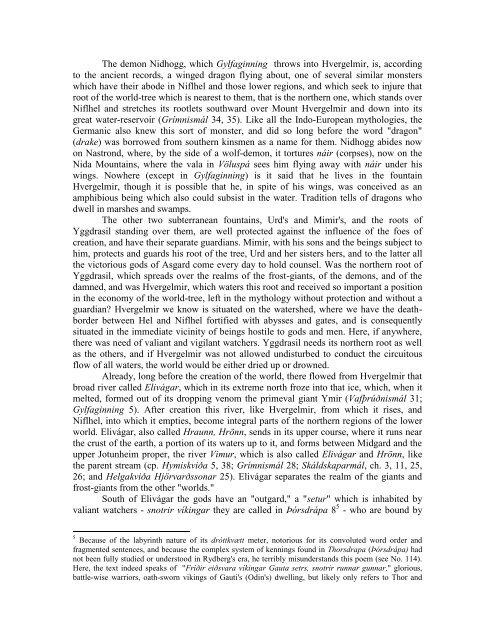Chapters 44-95 - Germanic Mythology
Chapters 44-95 - Germanic Mythology
Chapters 44-95 - Germanic Mythology
Create successful ePaper yourself
Turn your PDF publications into a flip-book with our unique Google optimized e-Paper software.
The demon Nidhogg, which Gylfaginning throws into Hvergelmir, is, according<br />
to the ancient records, a winged dragon flying about, one of several similar monsters<br />
which have their abode in Niflhel and those lower regions, and which seek to injure that<br />
root of the world-tree which is nearest to them, that is the northern one, which stands over<br />
Niflhel and stretches its rootlets southward over Mount Hvergelmir and down into its<br />
great water-reservoir (Grímnismál 34, 35). Like all the Indo-European mythologies, the<br />
<strong>Germanic</strong> also knew this sort of monster, and did so long before the word "dragon"<br />
(drake) was borrowed from southern kinsmen as a name for them. Nidhogg abides now<br />
on Nastrond, where, by the side of a wolf-demon, it tortures náir (corpses), now on the<br />
Nida Mountains, where the vala in Völuspá sees him flying away with náir under his<br />
wings. Nowhere (except in Gylfaginning) is it said that he lives in the fountain<br />
Hvergelmir, though it is possible that he, in spite of his wings, was conceived as an<br />
amphibious being which also could subsist in the water. Tradition tells of dragons who<br />
dwell in marshes and swamps.<br />
The other two subterranean fountains, Urd's and Mimir's, and the roots of<br />
Yggdrasil standing over them, are well protected against the influence of the foes of<br />
creation, and have their separate guardians. Mimir, with his sons and the beings subject to<br />
him, protects and guards his root of the tree, Urd and her sisters hers, and to the latter all<br />
the victorious gods of Asgard come every day to hold counsel. Was the northern root of<br />
Yggdrasil, which spreads over the realms of the frost-giants, of the demons, and of the<br />
damned, and was Hvergelmir, which waters this root and received so important a position<br />
in the economy of the world-tree, left in the mythology without protection and without a<br />
guardian? Hvergelmir we know is situated on the watershed, where we have the deathborder<br />
between Hel and Niflhel fortified with abysses and gates, and is consequently<br />
situated in the immediate vicinity of beings hostile to gods and men. Here, if anywhere,<br />
there was need of valiant and vigilant watchers. Yggdrasil needs its northern root as well<br />
as the others, and if Hvergelmir was not allowed undisturbed to conduct the circuitous<br />
flow of all waters, the world would be either dried up or drowned.<br />
Already, long before the creation of the world, there flowed from Hvergelmir that<br />
broad river called Elivágar, which in its extreme north froze into that ice, which, when it<br />
melted, formed out of its dropping venom the primeval giant Ymir (Vafþrúðnismál 31;<br />
Gylfaginning 5). After creation this river, like Hvergelmir, from which it rises, and<br />
Niflhel, into which it empties, become integral parts of the northern regions of the lower<br />
world. Elivágar, also called Hraunn, Hrönn, sends in its upper course, where it runs near<br />
the crust of the earth, a portion of its waters up to it, and forms between Midgard and the<br />
upper Jotunheim proper, the river Vimur, which is also called Elivágar and Hrönn, like<br />
the parent stream (cp. Hymiskviða 5, 38; Grímnismál 28; Skáldskaparmál, ch. 3, 11, 25,<br />
26; and Helgakviða Hjörvarðssonar 25). Elivágar separates the realm of the giants and<br />
frost-giants from the other "worlds."<br />
South of Elivágar the gods have an "outgard," a "setur" which is inhabited by<br />
valiant watchers - snotrir víkingar they are called in Þórsdrápa 8 5 - who are bound by<br />
5 Because of the labyrinth nature of its dróttkvætt meter, notorious for its convoluted word order and<br />
fragmented sentences, and because the complex system of kennings found in Thorsdrapa (Þórsdrápa) had<br />
not been fully studied or understood in Rydberg's era, he terribly misunderstands this poem (see No. 114).<br />
Here, the text indeed speaks of "Fríðir eiðsvara víkingar Gauta setrs, snotrir runnar gunnar," glorious,<br />
battle-wise warriors, oath-sworn vikings of Gauti's (Odin's) dwelling, but likely only refers to Thor and
















